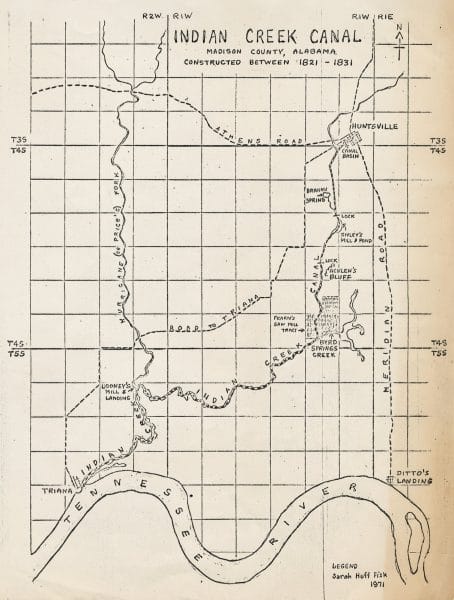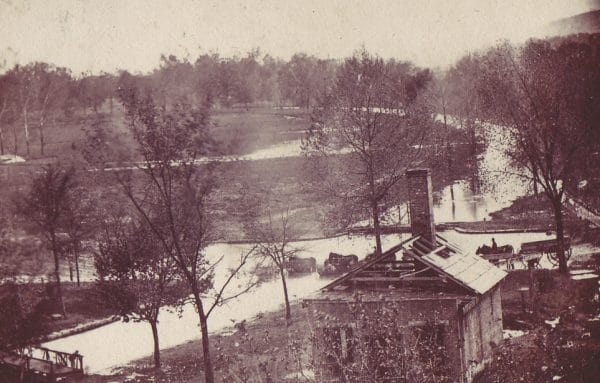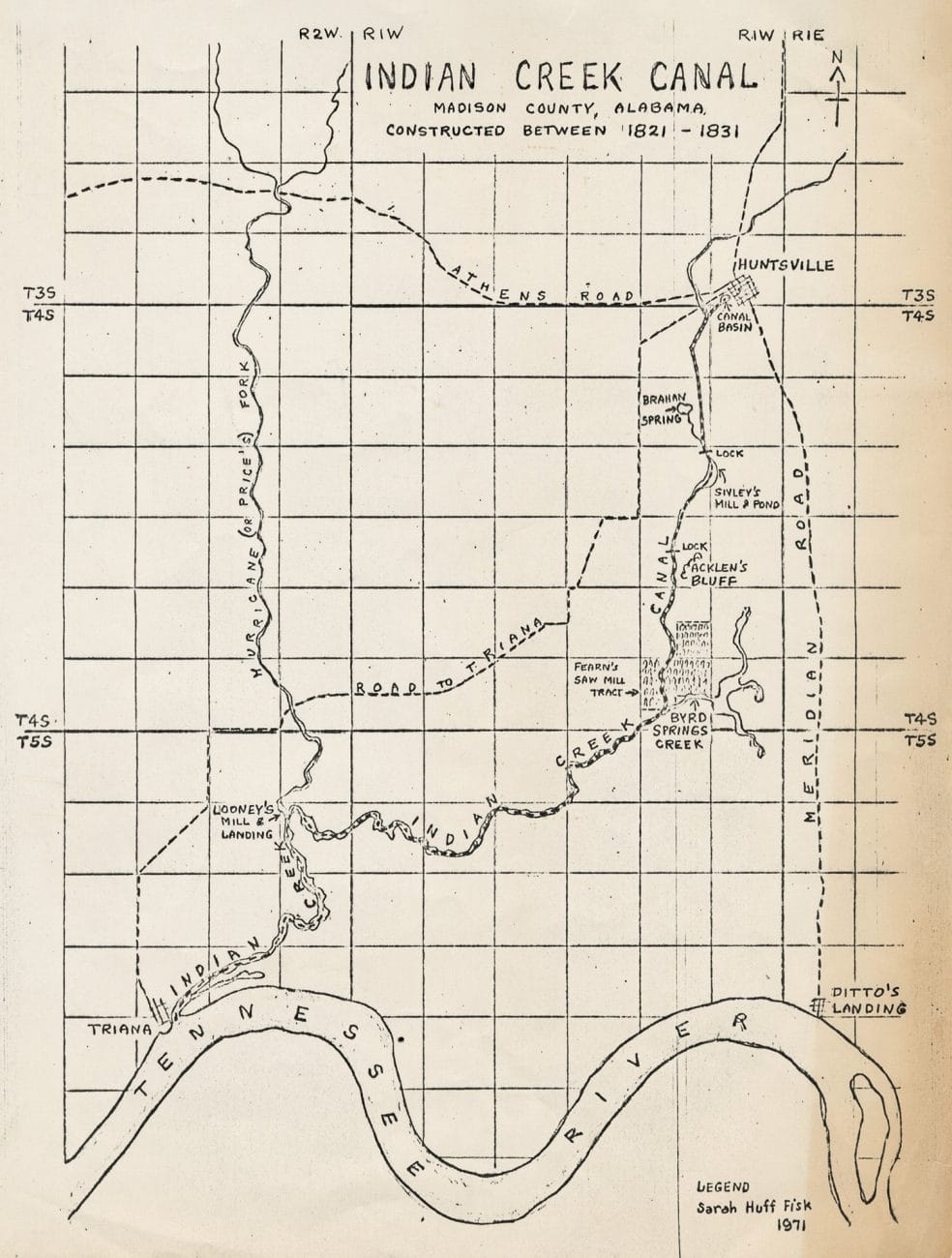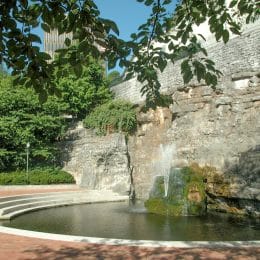Indian Creek Canal
The Indian Creek Canal once connected Big Spring in Huntsville, Madison County, to the Tennessee River some 16 miles to the south. Constructed in the 1820s for the transportation of plantation-grown cotton and other crops to the markets, it was the earliest known canal in Alabama and operated until railroads and a turnpike from the city to the river made it obsolete in the 1840s. It was also known as “Fearn’s Canal” for Thomas Fearn, the physician and businessman who oversaw its construction and led its promotion efforts.
City leaders had been looking for ways to promote Huntsville and also deal with the problem of navigating the shoals on the Tennessee River, which was usually only navigable for a few winter months when rain and snow runoff were plentiful. During those months, the river provided access to shipping routes on the Ohio River and the Mississippi River. Although Huntsville was a crossroads for trade and shipping from Tennessee, Kentucky, Virginia, and Georgia, its poor road system and relative isolation limited the availability of goods, making them more expensive for residents. Cotton growers and merchants wanted to get their products to market more quickly and when prices were high. Cotton was the leading export of Madison County, but transporting 250-pound bales was dangerous and expensive. The roads were in such bad shape that they imperiled the lives of merchants and their horses.
In December 1820, the Alabama legislature established the Indian Creek Navigation Company for improving shipping routes for cotton transported from Huntsville to the Tennessee River. It then went to New Orleans and ultimately to the textile mills in England. Other significant trade goods included cider, flour, lumber, salt, and whiskey. Five commissioners were appointed to oversee this effort: Thomas Fearn, LeRoy Pope, Stephan S. Ewing, Henry Cook, and Samuel Hazard. They were authorized to sell $50 shares of stock to finance the endeavor, which was estimated to cost between $25,000 and $30,000.
Construction began in 1820, with Thomas Fearn hiring enslaved and free laborers to dig the canal, paying them equally. The canal began at Big Spring and then headed south for 2.5 miles along Big Spring Branch, 10.5 miles to Looney’s Mill at Price Fork, and then three more miles to the Tennessee River. The canal was in limited operation as early as 1827. But because of financial setbacks, including original financiers backing out and a failed lottery in the mid-1820s, the canal and its five locks were not fully opened until 1831. Then, it could accommodate passenger boats and those, such as flatboats, hauling up to 100 bales of cotton. These financial setbacks were offset by Thomas Fearn and his brother, George Fearn, who contributed additional funds, thus earning the Indian Creek Canal the nickname, Fearn’s Canal.
Fearn’s pride and reputation were directly linked to the completion of the canal. He went so far as to subsidize the low price of transportation to encourage use of the canal. When it officially opened on April 9, 1831, the cost of freight was $0.37 per bale, less than half the price of shipping by wagon. (Transporting cotton on the ten-mile stretch of Meridian Road, the main route to the Tennessee, had cost $0.87 per bale in 1820.) Fearn dropped the price to $0.33 per bale that December. He also provided a warehouse in Huntsville to store cotton free of charge for those using the canal when the river was non-navigable. In 1832, the Tennessee River, Indian Creek, and several acres of surrounding land flooded because of excessive snowmelt in the east Tennessee mountains. The flood left behind silt and debris that needed to be removed from the canal. Undeterred, the Fearns advertised jobs at $0.75 per day for employees to help dredge the canal and repair the levees. These workers also built a warehouse and landing on the north side of the river at a location known as Butler Basin.
The Fearns entered into partnerships to help expand the use of the canal. In 1833, George Fearn formed a partnership with cotton shipper Michael Erskine to provide shipping from Huntsville to New Orleans from landings along the river at the rate of $0.20 per bale. In 1834, the Fearn brothers, Alfred Howell, and Thomas Patteson purchased early settler John Looney’s property at the Forks of Indian Creek, which included a mill, machinery, and warehouses. As cotton prices rose, the Fearns planned to form a new organization, the Huntsville Canal Company, to build a canal large enough to allow river boats and barges to travel from Huntsville to the Tennessee River. Although they had some interested parties, shippers were by then using railroads, including the Tuscumbia-Courtland & Decatur Railroad in the Tennessee Valley that bypassed the shoals, to export their products. The Fearns were willing to finance the new company themselves, but the financial crisis of 1837 ruined any prospects for the future canal company.
Traffic on the canal then dropped immensely after a paved turnpike was constructed along the Meridian Road from Green Bottom Inn to Dittos’ Landing, making a shorter, and cheaper, route for exporting freight. The canal was officially considered abandoned by 1859 by the author of the Huntsville Directory, City Guide and Business Mirror. In 1969, the Alabama Historical Association erected a marker at the canal’s basin on Gallatin Street in Huntsville to remind citizens of the continuous improvements of commerce in Madison County. A 1976 survey by the American Canal Society and the Historic American Engineering Record, a division of the National Park Service, found no remaining evidence of the canal or its locks.
Further Reading
- Fisk, Sarah Huff. “Huntsville’s Indian Creek Canal.” Huntsville Historical Review 33 (Winter-Spring 2008): 43-52.
- Gale, David D., Jr., “The ‘Great Pecuniary Sacrifice’ Dr. Thomas Fearn and the Indian Creek Canal.” Huntsville Historical Review 25 (Summer-Fall 1998): 1-22.














